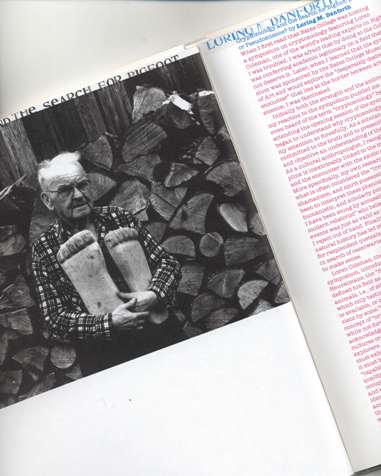
March 22, 2007

The Real Bigfoot and Genuine Bigfoot Tracks
Part 4: Stories of Pranks
by Mark A. Hall
Stories of Pranks
Northern California is a setting akin to British Columbia. It is a land of forested mountains where something the size of Bigfoot could be living. The American Indians had stories of the Oh-Mah and the Tok-Mussis which they largely kept to themselves until a news sensation in 1958 brought to public awareness the topics of immense footprints and hairy giants.
Against this background, the prank of leaving false footprints for others to find has been rumored going back nearly to 1924. A historical record and supporting testimony exist for the incident of “Ape Canyon” in Washington in 1924. [20] That account of “Ape-Men” and footprints 14-inches long is supposed to have inspired someone at a ranger station in Washington to put fakes on a lakeshore as a gag according to Marge Davenport of the Oregon Journal. [21]

Photograph of Rant Mullens in 1982, with an early pair of his wooden carved fake Bigfoot feet, image credited to Michael Dennett.
One of Rant Mullens’ stories told of his helping a friend scare some berry pickers with big tracks in 1930.[22]
Around 1950 at Trinidad California, a prank employing large fake feet was supposed to have been successful. [23]
None of these three stories rises to the level of historical fact because no contemporary record for them has been presented. Later they were recalled when people raised them as a precedent for the events of 1958. They might even be true in each case, but they have remained rumors. It is plausible that this type of prank occurred in the Western woods at different times over the years.
We have no particulars for the nature of events north of Korbel, California, on the Mad River in early 1958. Tracks were said to have been found there, but no one has revealed the details so that we could distinguish between a prank and something genuine like Bigfoot. People recalled later in 1958 only that some giant tracks were seen there. [24]
Tomorrow – Part 5: Tools for Hoaxing
Originally published in Wonders for December 2002 (Vol. 7 No. 4) pp. 99-125.
©2003 by Mark A. Hall. All rights reserved.
About Loren Coleman
Loren Coleman is one of the world’s leading cryptozoologists, some say “the” leading living cryptozoologist. Certainly, he is acknowledged as the current living American researcher and writer who has most popularized cryptozoology in the late 20th and early 21st centuries.
Starting his fieldwork and investigations in 1960, after traveling and trekking extensively in pursuit of cryptozoological mysteries, Coleman began writing to share his experiences in 1969. An honorary member of Ivan T. Sanderson’s Society for the Investigation of the Unexplained in the 1970s, Coleman has been bestowed with similar honorary memberships of the North Idaho College Cryptozoology Club in 1983, and in subsequent years, that of the British Columbia Scientific Cryptozoology Club, CryptoSafari International, and other international organizations. He was also a Life Member and Benefactor of the International Society of Cryptozoology (now-defunct).
Loren Coleman’s daily blog, as a member of the Cryptomundo Team, served as an ongoing avenue of communication for the ever-growing body of cryptozoo news from 2005 through 2013. He returned as an infrequent contributor beginning Halloween week of 2015.
Coleman is the founder in 2003, and current director of the International Cryptozoology Museum in Portland, Maine.
Filed under Artifacts, Bigfoot, Conspiracies, Cryptomundo Exclusive, Cryptotourism, CryptoZoo News, Cryptozoologists, Cryptozoology, Forensic Science, Hoaxes, Pop Culture, Public Forum, Sasquatch